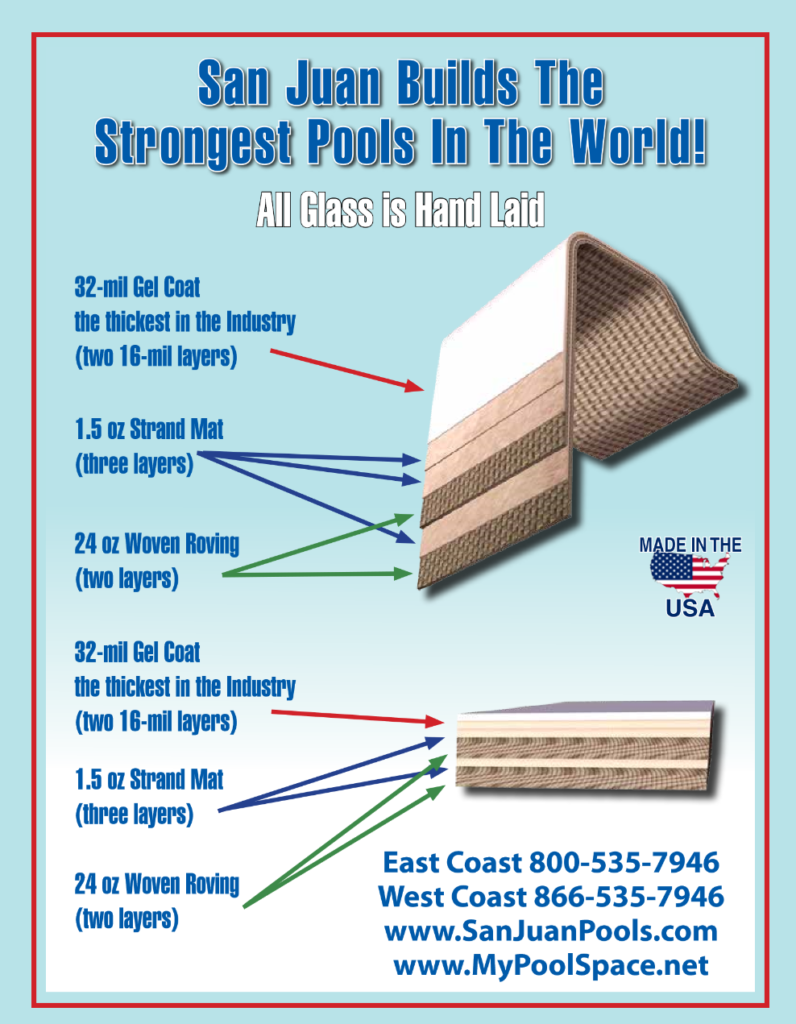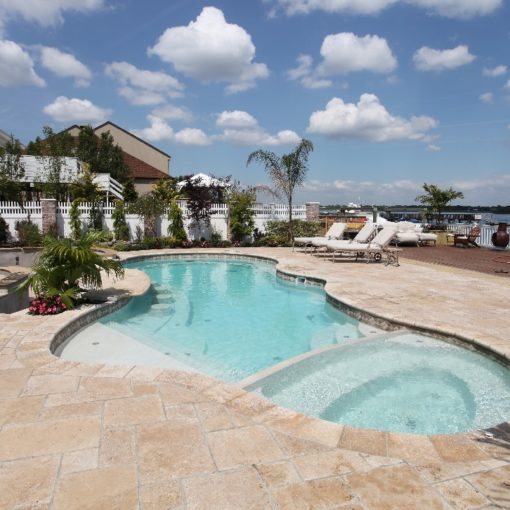
The secret is out. Fiberglass Pools are becoming the fastest growing segment of the swimming pool industry. Why? Fiberglass Pools have been around since 1958 and since then Fiberglass Pool manufacturing has grown tremendously throughout the country and abroad. I have been in the swimming pool industry personally now for 18 years and have seen tremendous growth in the technology and craftsmanship of these types of pools during the past decade. Let’s discuss the advanced technology San Juan Pools embraces and why we feel our exclusive manufacturing process dominates the industry ten fold. Artistic Pools now has over 1500 San Juan Fiberglass Pools Installed in NJ, PA, DE and Staten Island NY. We sell no other brand but the best… San Juan. Check out our interactive map showcasing every San Juan Pool we installed.
Shopping for a Fiberglass Pool – What to Consider
Shopping for a fiberglass swimming pool can be a daunting task. There are so many options to consider. Each manufacturer has a wide range of shapes and colors and each company touts their specific manufacturing process with guarantees that their product out performs another.
Most consumers have little expertise in fiberglass construction and even less knowledge about a wide range of raw materials. Therefore, in-depth product descriptions can be difficult to comprehend without some fundamental understanding of the primary materials and the construction techniques that are used to fabricate a fiberglass pool.
How can a consumer know that they are buying the best swimming pool possible or at least the best value for their investment? After all, fiberglass swimming pools (and all other types for that matter) are expensive. It doesn’t make sense to consider such a major purchase without first weighing the options in terms of performance. A well-constructed and properly installed pool should provide families with many years of recreation and low-maintenance enjoyment. But, a swimming pool costs the average consumer more than a new car and since most consumers spend multiple weeks considering which vehicle they want for their investment we should do the same for our outdoor living spaces?
Just like buying a car, we advise you not to look at the prettiest website or the best marketing campaign. It’s important to take a few moments to learn about how a fiberglass pool is built and what types of materials are installed in the construction process. What do Manufacturers guarantee in terms of their product performance? What is the cost comparison and what features are most important to you? For the purpose of this article, we focus primarily on the “Types of Materials and fabrication techniques” that San Juan Pools utilizes for our Fiberglass pool construction and help set us apart from all of our competition. We believe our fabrication process and materials are Superior because we don’t take the easy path. We utilize more expensive materials which require more fabrication labor because we are committed to building in the highest level of quality into our products. San Juan is well-known, not just as the grandfather of the fiberglass swimming pool industry, but for consistently building the highest performance products in the industry.
By understanding the differences that makes San Juan the industry standard for quality, you can understand why the secret to long term maintenance-free enjoyment is not what appears on the outside of the pool, but what is built into the fabrication of every San Juan product. After all, it’s what’s inside that counts!
The Boat Comparison
For consumers that live by lakes or beaches, they may be more familiar with boats than swimming pools. Despite one floating in water while the other holds water, both products are very similar in material composition and share common manufacturing processes.
Produced using a combination of fiberglass layers saturated with resins, both products are formed on top of a physical “mold” (pre-fabricated frame) that defines the shape, physical dimensions, and appearance of the end product.
This specific type of manufacturing process is referred to as Open-Mold manufacturing and is often used for larger product applications, such as boats & fiberglass pools. The result is a fiberglass shell that is theoretically water impermeable due to a chemical resistant gel coat surface finish that provides the final color and texture.
For the sake of boat hull and Fiberglass pool manufacturing, both utilize the same “open-mold” construction. However, it is important to understand that all “open-molding is not the same. Just as most of the higher-end boat brands utilize the finest raw materials or a high content of “hand-laid” construction instead of a “sprayed glass” process, San Juan is unique among all major fiberglass pool builders in utilizing this more costly production method. Why? Because we are committed to building the highest quality, longest lasting fiberglass swimming pool on the market! But since we don’t want you to have to take our word for it, we’d like to explain about two of the most important fiberglass construction factors which set San Juan apart from our competitors.
Hand-Laid vs. Spray Molding
So what’s the difference and why does it matter? Spray molding is a wonderful technology. It helped automate fiberglass construction and made low-cost shower stalls and other lower-priced large parts much faster to produce. Rolls of continuous fiber “gun roving” fiberglass are run through a “chopper-gun” which “chops” the material into short fibers and sprays them together with resin onto a mold. In the process, a considerable amount of air is entrapped and this is “rolled out” in an effort to eliminate entrapped air bubbles. Often, sprayed “chop” is combined in layers with other rolled glass materials to add strength and stiffness as the required thickness is gradually built up. This process was developed to reduce the amount of labor and material cost compared to the traditional, labor-intensive “hand-laid” process.
“Hand-laying” of fiberglass is much more labor intensive. It requires the meticulous combining of alternating layers of different types of rolled fiberglass. Each layer is “wet out” with resin and carefully rolled out into the mold. The process is repeated with alternating layers until the desired thickness is established.
Why is a “hand-laid” product superior to a “spray-molded” construction. There are several reasons. First, the strength of fiberglass comes from the glass fibers, not the resin. The resin is just a binding agent for the glass. The more glass, relative to the amount of resin, the stronger the part. Spray roving requires much more resin “wet out” the chopped fiber. Typically, in two parts of equal thickness, one produced with a chopper gun and one produced by hand laying, the “chopped” part will contain nearly 20% more resin. While the parts may appear to be the same thickness, since virtually all of the strength comes from the glass, the “hand-laid” part is substantially stronger.
The second benefit of hand-laying is that encapsulated fiberglass is stiff. When you make a large part like a swimming pool, the pool must be transported from the plant to distribution or in most cases the job site and handled by a crane to place it in a pre-excavated location. During the loading and unloading and all of this handling, the pool endures a lot of flexing, which can create hairline cracks in the gel coat surface, leading to future performance issues if shortcuts in manufacturing are taken.
The third benefit of hand-laying is that it is virtually impossible to remove all of the air from a spray-molded part. No matter how much rolling is performed, thousands of tiny air bubbles are entrapped in the fiberglass. Not only do these bubbles weaken the pool, but they invite the intrusion of chlorinated water which, over time can create surface blisters and degrade the fiberglass matrix.
The fourth benefit of hand-laying is that spraying gun roving is an inexact process. Even an experienced chopper gun operator can only approximate the consistent thickness application of the chopped matrix, compared to a precisely manufactured rolled glass mat of exacting thickness. The result of a properly fabricated hand-laid construction pool is a much more uniform part thickness with consistent strength throughout the entire component as compared to spray construction.
These are important considerations and at San Juan, we have maintained our commitment to making the best products possible and have resisted the use of less expensive processes with reduced labor in favor of building what we believe are the highest quality products in the industry! This is just one of the reasons that owning a San Juan pool has always carried the prestige of owning the best of the best!
Raw Materials
Every day, we all make decisions about where and how we will spend our money. Few of us eat every meal at a five star restaurant and, regardless of the type of car we drive, there is almost always another manufacturer which is more expensive and arguably better in some respect. Sometimes we may believe that First Class or Business Class is justified when we purchase a flight, or perhaps you prioritize Hilton vs Marriott when you select your hotel.
When products are manufactured, the producer also makes value judgements. For a given application, their priority may be to build an acceptable product, a good product, or a premium product. At San Juan, our standard has always been to produce the very best product we can and to utilize the best materials and construction techniques which will allow us to meet that standard.
Not only is the process of hand laying vs. spray construction more costly because of the higher labor content, but the fiberglass material itself is significantly more costly. Could we change our process? – not without compromising the quality that San Juan is well known for.
In producing a fiberglass swimming pool, the three primary categories of raw materials are Gel Coat, Fiberglass, and Resin. In each of these categories, San Juan strives to use the very highest quality among the various available options.
The first thing you see on a pool is the colored surface. This color (including white) is a resin-based product called gel coat. A huge amount of composite technology is focused upon gel coat because it is what you see and it is the surface which must withstand the wear and tear of the application. You want the color to last in a harsh chemical environment and you want the finish to retain it sheen. You also want the surface to remain crack free and resistant to blistering. There are a many many grades of gel coat and the prices vary significantly. At San Juan, we use only the highest quality Iso/NPG grade gel coats for color retention with maximum cracking and blister resistance. The quality of the gel coat also helps protect our molds, which ensures the surface appearance for which San Juan products are world famous!
For the glass itself, we are very discriminating, because experience has taught us that the standards for each of the three types of fiberglass we utilize in our construction must meet the highest standards. We don’t want to expend added construction labor only to find that the benefits are compromised by using lower quality materials. While price is always important, we shop quality first and price second. Since being a supplier to San Juan imparts a certain amount of prestige to a supplier, we believe that our large volume, coupled with our reputation for quality will encourage suppliers to give us competitive pricing on the best raw materials.
For the resin, virtually all pool manufacturers use two types of resin. For the layer behind the colored gel coat, they utilize a skim coat of vinyl ester resin, which effectively stops the penetration of water into the laminate. Not only does the vinyl ester create a very strong chemical bond to the gel coat, leaving no room for water penetration, but this epoxy-based material provides both strength and flexibility. Unfortunately, vinyl ester resin is expensive. For this reason, virtually all pool manufacturers utilize as little as possible, providing a thin skin coat behind the gel coat, only as thick as required to provide a good barrier against water intrusion. This thin layer is backed up by a much thicker “bulk laminate” usually made of chopped glass and a much less expensive polyester resin.
However, just as we do with fiberglass, San Juan is one of only a handful of companies in the entire world which constructs the entire pool out of vinyl ester resin. Why would we incur this kind of additional cost? Because we want to build a truly superior product compared to our competitors. We believe that our 100% vinyl ester resin pools, utilizing 100% hand-laid fiberglass construction are the strongest, most water impervious pools in the world! We could make them cheaper, but they would not be a San Juan Pool.
Key Differences: What Makes Fiberglass Pools Unique
As you might have guessed, although fiberglass pools and boat hulls are similar in design and function they are not 100% identical and have some foundational differences. Designed for different applications both products utilize similar manufacturing techniques but require different material makeup due to strains placed on them by their physical environments.
Boats are often manufactured using a combination of fiberglass & polyester resin. Designed to be flexible and more cost effective, polyester resin is typically applied in boat hull manufacturing due to its cost savings comparable to vinyl ester resin (more expensive) or epoxy resin (most expensive).
Fiberglass pools on the other hand are manufactured using a combination of hand-laid or chopped fiberglass & oftentimes vinyl ester resin due to its ability to combat the onset of osmosis below the gel coat (a common problem in the boating industry).
Hand-laid Versus Chopped Fiberglass
In layman terms, there are two main considerations for fiberglass swimming pool construction:
Type of Fiberglass – Spray (Chopped) versus Hand-Laid (Complete) Sheets
Type of Resin (for Binding) – Epoxy Resin vs. Vinyl Ester Resin vs. Polyester Resin
Just like in car manufacturing, a fiberglass pool manufacturer is able to combine any sort of combination of the above listed materials in a wide array of arrangements to produce their finished products. Hence, each manufacturer claims to have the best “recipe” for constructing a top-notch fiberglass swimming pool. It’s here that most manufacturers spend their time discussing their “quality” versus another manufacturer.
Out of respect for our competitors, we are only going to focus on the ways in which San Juan Pools differentiates ourselves based on the quality of our products.
Hand-Laid Fiberglass Sheets and 100% Vinyl Ester Resin is all we know….Since 1958
 San Juan team always 1 step ahead of the competition
San Juan team always 1 step ahead of the competition
Fiberglass Pool Comparative “Why we are the Best”

For a Free Instant Quote on any San Juan Pool or Spa Please Click here




4 thoughts on “Fiberglass Pools”
Fiberglass pools look like a fantastic low-maintenance option! Love the durability and design flexibility.
I like how you mentioned that it is a good idea to learn about how a fiberglass pool is made before you purchase one. In addition to that, I would think that it would be a good idea to have a pool contractor come to your home and look at your yard. You would want to make sure that your yard is big enough for a swimming pool.
Amazing post. What an amazing fiberglass pool process steps you have, its almost like building a boat from plug. I would feel confident that my pool would not rot using these fiberglass steps.
Good to know the pool industry is changing. By applying better materials, everybody wins. Thanks a lot